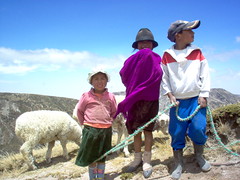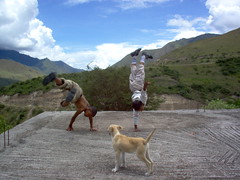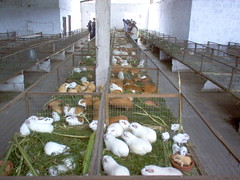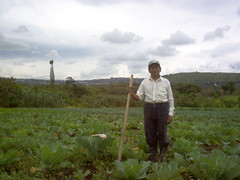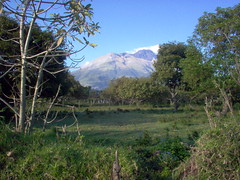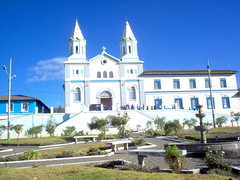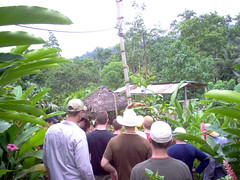Saturday, November 24, 2007
I will spare all the details of my need for a site change, if any one just has to know send me an email and I’ll spill the beans. Very briefly, it was just a matter of my counterpart organization falling apart at the seams, racked by internal strife and major changes in direction. The farm has been put on the market for sale. Gilberto, Suzanne and the kids have moved to a tiny rented house in Milagro, and their life has all of a sudden become more difficult and precarious, if that’s possible. Jobs are scarce, Gilberto has no skills except as a farm laborer, and he swears he will never do farm work again, unless he has his own place, which is a virtual impossibility for him. Suzanne will earn some money cleaning offices and doing other people’s laundry, but it won’t be much. The job situation is so bad here that some estimate almost 1/5 of the population has left the country, legally or not, to seek work in the US or Spain. Almost any one I encounter here has at least one family member working abroad. Ecuador’s economy is shaky at best, and it will be years and years and years, if ever, before there is any amount of change. Global trade policies, and especially US sponsored trade initiatives do no favors to Ecuador; but after spending 9 months here and watching and learning and interacting, it is impossible to pin all the blame on outside influences, as much as I would generally like to. I’m no economist, or political scientist, so I have to be careful not to get in over my head here, but it is quite apparent that so many of Ecuador’s problems are internal – from the lack of interest in running the corner tienda in anything even remotely resembling an efficient manner, to the interminable meetings tying up the time of 40 – 50 people while EVERY late comer loudly interrupts the proceedings to wish a good day to EVERYONE, or where an hour is spent deciding if a good price for carrots is 8 centavos cada libro, or 9 centavos cada libro. A country where almost every transaction,including buying a stamp for a postcard, has to be documented and usually signed for. I have a ping pong table at the farm which I have offered free of charge to the local authorities for community use. With help from the local librarian, I tracked down the proper people, and several lengthy discussions followed. Ultimately, we had to write a letter, in triplicate, explaining all the virtues of the ping pong table, and then have it signed by all parties involved in order to seal the deal. And let’s not talk about “ya mismo” which I referred to in an earlier entry. Friends of mine who have traveled or worked extensively in Ecuador’s neighboring countries Peru and Colombia assure me that neither country shares these irksome traits. Yes, in some ways it’s all very charming, but the shine wears off pretty fast once you start connecting the dots and seeing how the culture of inefficiency and indifference keeps so many people buried in the darkest depths of poverty, hunger, and hopelessness. As a Peace Corps volunteer, someone who is supposed to be “helping”, it’s especially frustrating, because in so many cases the poorest of the poor are so far outside of the system that frequently we can not reach them – or, especially in the case of many of the indigenous – the fear and suspicion of outsiders is so strong that most, if not all approaches are rebuffed. Sure, we generally work with a poor population, but almost everyone I work with has a pair or two of shoes and can get to Ibarra from time to time. There are many out there who have not and can not.
Right. Not sure what that bunch of generalizations has to do with my site change, but there they are.
Ambuqui is fantastic, a hot and dry climate, and a warm and friendly bunch of people. About 800 people live in town, about 8000 in the whole paroquial, which is rather large and diverse both in culture and geography. Ambuqui is one of the very few places in Ecuador where you will find Afro, mestizo, and indigenous all living and working shoulder to shoulder. I’m working with an Ecuadorean foundation called AGRECO, and I am busy. Crazy busy. We have 2 major projects right now, both well funded by the Inter America Foundation and the European Union, with lesser amounts made available by the Republic of Ecuador and the provincia of Imbabura. The larger project is focused on food security – just a fancy way of saying people need enough to eat. I am very active in this one, working with farmers in several communities in the valley and several others in the mountains to try and diversify the crop base and minimize the use of herbicides and pesticides. Some of this work involves grain and bean farmers, some involves families just trying to get some food on the table. Another volunteer, specializing in health and nutrition, would be an asset here, but in the meantime I am incorporating those aspects into all of my “charlas”. The other is a reforestation project, and part of my role in this one is to educate about and encourage the use of pasture land and livestock enclosures. There are thousands of domesticated goats in the highlands, and the damage they do to the flora is mind boggling. It is impossible at this point to plant tree seedlings in any significant number – they would be eaten in days. I am not well informed about animals and pasture, so this is a big challenge for me.
More about Ambuqui next post.
Wednesday, November 7, 2007
So here I’ve let another month pass between entries. How the time flies. I’ll try and catch up as succinctly as possible.
Lori and Colin Gatland from way out in the western edges of Ohio came for a weeklong visit at the end of September. I had met Colin several years ago in Spanish 101 at Sinclair C.C., in Dayton. He and Lori are always off on some kind of adventure or another, more often than not in Central or South America, so a weeklong trek to Ecuador was not highly unusual for them. We had a great time, and despite our abbreviated schedule we took in some pretty interesting and varied terrain. One of the highlights was our 3 nights at Hostal Cloud Forest up in Chugchilan, high in the Sierras, especially the hike from Quilotoa Laguna back to Chugchilan. Quilotoa is a dead volcano (3900 mt.), and its crater is filled with almost 800 ft. of brackish water with no known inlet or outlet. It’s quite a sight to approach the crater edge and to all of a sudden encounter the expanse of emerald blue water. All around the crater the wind was howling and it was quite chilly. The hike to Chugchilan took us about 6 hours, although it can be done in less time. We were lucky, and encountered along the trail a young (11) indigenous boy named Cleber who agreed to guide us as far as Guayama for 5 dollars. We were glad to have him, and he was great company. Parts of the hike are strenuous, especially the climb back up the valley to Chugchilan. The scenery was spectacular, but that’s the case throughout this entire country. We got back to the Cloud Forest in late afternoon, the day had grown quite warm; we dropped our packs, took off our shoes and enjoyed a couple of very cold Pilseners.
The day before, Colin and Lori had rented some horses and went way up into the bosque and the paramo. Since riding doesn’t suit my back, I opted for a long hike down into the valley to the river. About 2 hours down, and 4 hours up. On my way back, I passed a small mud house which had a few cola bottles perched on the ledge of its single window. I stopped to have a drink, and when I stepped in the door I found a woman and her daughter hard at work at a treadle powered sewing machine. Behind them were several dozen uniforms, which are required for most of the schools here in Ecuador. We talked for awhile, and I learned that they made a pretty decent living from the uniform business, usually about 140 dollars a month, sometimes a little more. There are plenty of places here where families get by somehow on only 60 or 70 dollars each month.
We left Chugchilan in the back of a milk truck, along with 2 new friends from Switzerland, whom we had actually met several days before, in Quito. It was a beautiful day, and a great ride, all the way to Sigchos. In Sigchos we had hoped to hop on a bus to Latacunga, but it was Election Day and the busses were jam packed until very late in the day. So the five of us pooled our resources and we found a truck driver who would take us the 2 hours plus to Latacunga. We piled in, ready for another pleasant trip through the Andes – the sun was strong, the air was hot. Within an hour, we had climbed thousands of feet and we were all freezing! The only thing that kept us from hypothermia was the fact that our driver picked up about 15 more people en route to Latacunga, and we all huddled together as the driver flew down the road. The weather stayed cold, even as we descended back to the Pan American Hiway, and we were all relieved to finally get out of the truck and into the relative warmth of the next bus. Our friends were headed for Ambato, and we were passing through on our way to Puyo, in the Oriente.
In Puyo, we mostly laid low for two nights, played cards, and took walks around town. Puyo, a hot and humid place, affords ample opportunities to go “el dentro” into the Selva, but we had neither the time or energy. We relaxed, for the most part, but we did visit Parque Omaere, a protected refuge of rainforest plant species. We lit out the next day for Tena, stashed our gear in a hostal, and went straight down to the little town of Misahualli. We met up with a boat owner named Freddie down by the Rio Napo and climbed into his canoe, the “King Kong”. In a moment, his family had climbed in as well, and we had a nice float for a few hours up and down the river. We encountered families panning for gold along the banks, families doing their laundry, and at one point downriver we stopped for a couple and their load of cargo which they had to get up to the mainland. I think the three of us would have liked to have had a little more time around the river, but Colin and Lori had a plane to catch back in Quito – so the next morning we were on an early bus out of Tena. We got back to Quito about mid-day, and then spent a few hours straddling the equator at the “Mitad del Mundo” park west and north of Quito. That evening we had dinner with some Peace Corps friends in Quito, and the next morning brought (for Lori and Colin) a 4 AM departure for the airport. All in all, a good trip.
Colin has created a nice link to Hostal Cloud Forest, listed over to the right - check it out.
OK, not very succinct, I admit. So I will close here, and very soon will post again about my recent site change and my new home here in Ambuqui, in the Valle de Chota.
Thursday, October 4, 2007
In Misahuali
Sunday, September 16, 2007
Ya mismo
I mention ¨ÿa mismo¨ because that´s what I keep telling myself when I think about making posts to the blog - coupled with the fact that time just absolutely flies by, I end up with almost 2 months since my last post. What follows is a collection of rambling observations made here and there.
The 2 or 3 of you who check this blog may notice a lack of references to Peace Corps; I am finding that one of the great things about PC is, that once we are done with training, and we are out in our sites and in the real world, Peace Corps becomes just background noise - it´s always there, but very subtly. If I need something from PC, tech or language training, or help with minor or major problems, then there they are - sometimes able to help, sometimes not. But in day to day life, I am just ¨Royer¨, or ¨meester¨ an ¨agronomo de los Estados Unidos¨. I, for one, like the autonomy.
--------------
Ecuador is at least 3 different countries - the coast, the sierras, and the oriente. Within these 3 regions exists hundreds, or thousands, of other countries, places isolated by language, distance, lack of education,and culture. My friends here on the farm, Gilberto y Susanna, know nothing of Ecuador apart from this region, where they were born and have lived their lives. When I travel, for work or pleasure, and mention to them where I am off to, Mindo, or Vilcabamba, or Nanegualita or Los Bancos, they know nothing of these places. They are as inconceivable as London, or Prague, or Perth. I have 2 maps hanging in my room, one of Ecuador and another of the world. From time to time we will all gather ´round the maps and have a look - all are astounded by the size of the continents, and even more so by the size of Ecuador. ¨Muy pequeño!¨ is the common exclamation, followed by the unsettling realization that Brazil, the States, and Europa are ¨muy grande¨. These represent impossible to imagine worlds of wealth, leisure, and ¨chicas in bikinis¨.
------
I have been doing some exploring lately (being wealthy, relatively speaking, and with leisure time - meaning I do not work 12 hours a day 7 days a week). I hop on buses with placards in the windshield promising ¨Selva Alegre¨, or ¨Rio Verde¨, ¨La Esperanza¨or ¨Pimampiro¨. Though the distances involved are usually short, as the crow flies, some of these trips are agonizingly difficult due to the mountains and the road conditions. At times, realizing that to reach my mystery destination will end up taking the entire day, I jump off a bus and start walking home, hoping to catch a returning bus or friendly camionetta.
Even now, in 2007, the difficulty in getting to and from one place or another in Ecuador is hard to fathom. Villages that are 1o miles distant as the crow flies are often reached only after an hour or much more of torturous roads interrupted by landslides, washouts, and cattle drives From time to time when 2 vehicles encounter one another, (and have avoided a head on collision and the 600 ft. plunge down the valley), the uphill heading vehicle will have to spend 5 - 20 minutes backing up to find a spot wide enough to accomodate the passing width of the downhill headed vehicle - usually another bus or an oveloaded (with people, with cattle, with sheep, or any combination) truck or wagon. The whole operation becomes impossibly complicated when a third, or fourth, vehicle enters the picture. Most of the time the thing is settled without mishap or fatalities - Ecuadorean drivers, though impatient and rude, are incredibly skillfull and inventive. I have found the best way to deal with the stress of a bus trip is to take a nice long nap, with fingers crossed.
Tuesday, July 24, 2007
Lagunas Mojanda
The Beer Post
Pilsener - it´s not a type of beer, it´s a brand. There are others, Club(pr.¨cloob¨), Club Verde, Brahma, Clausen, Dorada,several ¨lites¨(not reviewed). There is supposedly a brand called Biela, but I have yet to see it. There are microbreweries in Quito, I have been to only one - and the beer was undrinkable - overcarbonated and way too fruity. According to Quito veterans, there are very good microbreweries in Quito - including a place called Turtles Head, maybe somewhere down the line I´ll get to try them.
Meanwhile, we´re focusing on good, cheap, regular beer. And that´s what Ecuadorean beer is all about. Pilsener is without a doubt the king of beers here - but Club Verde is a much better brew, using the word ¨¨better¨advisedly. Both are lightweights in terms of alcohol, about 4.5%, or a little less. Suits me fine, of course.
Here´s the clincher - a 12 ouncer of Club Verde, in a Euro style green bottle, goes for about 1.25 in the tiendas, if they have it. A big 22 ouncer of Pilsener (returnable) goes for .70 centavos. Prices somewhat higher in restaraunts. Most of us are going to go for the 22 everytime - the quality difference is simply not significant enough to do otherwise, especially when one is living on 7 dollars a day - or much less if you´re an average Ecuatoriano campesino. And when you´re thirsty, and when it´s cold, really cold - man the Pilsener is not too bad - I´d take it over Bud or Coors or Mich any day of the week . A little bit like High Life, if not a little better. Dorada, also by the same brewery, is the same price as Pilsener, but suffers a marked decline in quality.
Interesting to note that both Club and Pilsener are brewed by the same company, some folks think they are the same beers only presented differently. I don´t agree - especially regarding Club Verde. The regular Club is often sold in cans and is horrible, undrinkable except in cases of dire emergency.
One can find, in restaraunts and haciendas, imports like Heinekin and a few Canadian Brews, and in Riobamba we came across a German Deli that had a few Heffenweises and Oktoberfests - Spachen? I think they were. But the bottom line - if you´re going to drink beer in Ecuador, you are going to drink Pilsener. And you´re gonna like it.
My best beer drinking experience (with Ecuatorianos) to date was on Father´s Day. I had no idea what day it was, but at 11AM Gilberto was at my door with a cup of beer - ¨Feliz del dia de padre!¨ and all his brothers and in laws were downstairs coaxing me out of my morning reverie. I chucked my days plans out the window and joined them - we drank about 20 bottles of Pilsener between us, every single drop from a plastic cup passed continuously. I got out my guitar, we found some plastic buckets and cardboard boxes to bang on, and Gilberto´s brother played all afternoon. Around sundown one of the proud dads sent his 9 year old son to the tienda with a 10 spot to buy a bottle of whisky - at that point, I made my apologies and called it a night. Ecuatorianos handle their beer well - but put whisky and rum in them and you have no idea what could happen, except it probably won´t be good.
Well, now I´m thirsty, and I´m in Ibarra, and it´s close enough to dinner time to think about eating - some fried pig, with some llapingachos and mote, and a big cold Pilsener. Buen Provecho!
Saturday, June 23, 2007
what´s for dinner, ma? Cuyes!!
We also went to the Polylepis Lodge up near Columbia, in Carchi Province. Some spectacular scenery of the paramo and the small amount of polylepis forest remaining in the Andes is a surprise, to say the least, in that it is a boggy landscape more likely to be found in Nova Scotia. I have some pix posted at the flickr link.
There was a beautiful crescent moon last weekend, with the crescent at the bottom of the sphere - something I think we do not see in the states. Also seen, for the first time by me, was the Southern Cross constellation, I mean it when I say it was breathtaking.
At the lodge was a high school group of about 40 from the coast, and one of my ecuafriends introduced me as a famous american singer of cowboy songs. I could have killed him, and probably will someday, but for the moment I had no choice but to fake my way through the only 2 even remotely cowboy songs I know - fiddler a dram¨and ¨¨tennesee stud¨. Äfter both ¨songs¨ my audience erupted into enthusiastic cheering and calls for more - I was mortified and passed the guitar to a young man who spent the rest of the night playing beautiful south american folksongs and poptunes, which everyone knew and sang along to. His performance was far far superior to mine! A lovely evening, all in all. (Still researching the beer post, it´s a lot of work, let me tell you)
Saturday, June 2, 2007
Segundo
I tell him people earn 10 dollars an hour in the states, and he says, yeah, but what do you pay for rent and light and water? He's got no complaints.
a day in the life
Today, being Friday, we were to meet, but it is also the first of the month and both G. and S. were hot to run into town (.18 centavos by bus) to collect their monthly salary, so we agreed to meet tomorrow instead. G. receives around 160.00 monthly for his work on the farm, S. receives 60.00 monthly for her work with the cuyes. (Guinea pigs) Their housing, such as it is, is gratis and includes utilities which more often than not seem to work. As a comparison, my Peace Corps “stipend, not a salary” is 7.67 daily, or 230.00 mensual, and my housing (such as it is) is paid for as well. Anyway, for campesinos, their pay and housing perks are the talk of the barrio – most people here in the campo can only dream of a sweet deal like that.Today was also the day I aimed to begin a little tradition, hopefully to continue for the duration of my stay. First Friday of the month, I buy, or prepare, dinner for myself and the family, and then we play ping pong and listen to really loud bomba music. Since they were going to Ibarra, G. and S. suggested we try some comida from the restaurant where his sister works. 6 dinners, at 1.25 apiece, not bad. They were to return around six.
Meanwhile, I go upstairs to my cuartos to study Spanish, drink a little rum, and perhaps play some chess or scrabble on the computer a friend has loaned me. Ten minutes later, I hear a ruckus at the gate, and me and the kids walk up to check it out. A gigantic truck, with what looks to be 30 or 40 ton of chicken shit in the bed is trying to negotiate the sharp turn into the farm. He was supposed to be here about 8 hours ago, when there was a full workforce available to unload (dumptruck? Yeah, right) So we get him thru the gate, and with darkness coming fast me and the 2 boys guide him down the camino to the first offload where, using shovels and rakes, we dump about 1/3 of the load. On the way to the second offload we forget all about the irrigation ditch and the guy puts his right front tire into it. Our meager complement of 1 man and 2 boys was not enough to help the driver free his rig. I offered him my sympathies, and he set off on foot to walk the 45 minutes home. We will have to hire a tractor to come pull him out, probably at 7 AM tomorrow.
By now it’s fully dark, and a misty fog has crept in. Where are S. and G. with our dinners, we all wonder. Since it’s past 7 PM there are no more buses, so they will have to take a cab from Ibarra (2.00) and walk in from the main road, no fun in the dark, and S. in her town shoes. An hour later, with cold food, they arrive, S. a little bummed about her muddy shoes. We all cram into the front room of the family’s casa which has more furniture than space, including the biggest boombox I have ever seen. The eldest son accidentally opens the food container upside down and spills it all over the floor. He gets a swat on the ass from Gilberto, but the 3 dogs and the cat are in hog heaven. There are 11 billion flies in the room. Dinner is chuleta, a pork cutlet. I am wary of eating pork, since the PC nurses always tell us horrific stories of all the worms and parasites in undercooked pork – but damn, it’s always so good. There are side dishes as well – potatos (surprise) and mote, a kind of corn that is, well, kind of bland. There are 2 fundas, one is full of aji, a kind of salsa picante, and the other is mayonesa, which is really watery mayonnaise. It’s delicious, and really dresses up the mote. Since it’s a special occasion, Gilberto breaks out the chi-cha, which I suspect is leftover from the past Sunday’s confirmation fiesta. We are all starving, so we eat and drink mostly in silence, occassionally recounting the events of the day, and wondering how it will go tomorrow when we try to pull the truck out of the ditch.
Tuesday, May 15, 2007
Although my Spanish is steadily improving, there is a constant disconnect between what I thought I understood and what was really meant. I talked to an Ecuadorean friend and she said that even Ecuapeople have that same problem, the same disconnects. She said it teaches one to be very patient - and indeed in this country, people are very very patient. When´s the last time anyone reading this waited in line at the bank for 2 hours, or more? Sat on a bus going no where for 30 minutes while the driver jumps off to go talk with an old amigo for a little while? Tranquilo Tranquilo Tranquilo.
Spent the night in Quito last Thursday, went out to dinner with friends from PC and some of us went to a great jazz club called El Pobre Diablo and heard some excellent music. It kind of felt like being in Manhattan, exposed beams and brick, framed posters on the wall, a few berets and ponytails here and there. It was fun.
Also fun is my work on the farm. I have negotiated about a half acre on which I can experiment with organic methods as well as non traditional crops. I have started compost piles and the construction of planting beds. Cleaned out the greenhouse and have started basil, peppers, marigolds, and lettuce. Although there are succesful organic farms in Ecuador, none of them seem to be here in the northern sector. My campañeros scoff at my chances of success, and I´m not even sure what that word means within the context of my Peace Corps experience. In my own mind, I will consider my venture successful if a few people get the idea that soil health is a rather important part of good farming.
The weather has been beautiful, last night was clear and I saw loads of stars which so far has been a rare experience, since most nights seem to be rather cloudy. Next time I post I hope to have very important information regarding the price of beer here, complete with photos and taste tests. Ciao
Monday, May 7, 2007
how wrong could I be?
view from the farm in Ibarra
Last week a family walked onto the farm looking for the new gringo. They had an English language photocopy of "Candyman" the nasty, double entendre filled old blues tune by Mississippi John Hurt or some such person.. / The daughter's high school class was going to perform the song, in English, at an upcoming school fair, and they needed help with phonetic pronunciations of all the lyrics. So I walked up the road to their house, and spent the next 2 hours teaching pronunciation of phrases like "he gets me so hot, makes my panties drop" or " gets me so hot, makes my cherry pop" I did not have the will, or the language skills to make any mention of the horny lyrics; but I feel like I could go home today having accomplished in full the "cultural exchange" portion of Peace Corps mission here. Next week is the performance, I hope to go.
Yesterday, Sunday, I was out preparing the first of what I hope will be many raised beds for planting. Shirt off and shorts, trying to shed a little whiteness, I was working and sweating, listening to the amplified church service out of El Milagro. A fine womans voice and some acoustic guitar, singing praises, it was certainly mellow. The service wrapped up, and within moments the speakers were blaring out the "all cumbia, all the time" station. It nearly knocked my socks off when I heard the Cumbia version of "California Dreamin" by the Mamas and Papas. I am not kidding. One of the households up the hill then started blasting Bomba music from the opposite direction, man some of these folks have some pretty powerful stereo equipment. Between the barking dogs and the radios, Ecuador can sometimes be a hard place to find some peace and quiet.
Thursday, April 5, 2007
San Bernardo kids
I´m posting more photos to Flickr.com, and hope to add more about the trip in the next couple of days. Ciao.
Tuesday, March 27, 2007
Photos finally
Ciao
Sunday, March 25, 2007
Domingo 25 de Marzo
The past week has been full of incredible experiences and meetings with dozens of new people. In less than one month, after swearing in in Quito, I will be returning here to Ibarra and El Milagro to begin the next two years of my life. At times this all seems surreal! At El Milagro I will be living and working on a small farm - about 6 acres - which currently raises chickens, quail, and cuyes (guinea pigs) (not for pets), alfalfa, and many varieties of vegetables. My main occupation in the coming 2 years will be to help the farm make a transition to organics, and to provide outreach to some of the other communities we (UCAN) will be working with. UCAN if I have not mentioned it before, is my counterpart organization. Largely funded by a Canadian cooperative, UCAN works with Peace Corps and other aid agencies to bring new techniques and sustainable technologies to various populations in the Imbabura and Carchi provinces here in Ecuador. Much of their work is in the Chota Valley, north of Ibarra, populated largely by AfroEcuatorianos who grow sugar cane and tomatoes. Also served are mestizo and indigenous populations.
In yesterdays post I mentioned Nick Zetts in Cahuasqi - his town is predominantly mestizo and he is working with a farmer who wants to move towards organic production. One of the concepts Peace Corps drives home is that we volunteers are to serve as ëxtensionist multipliers¨ - meaning that, with hard work and luck we assist one person or group who then assists another, etc.
There are challenges here which simply do not exist in the U:S: The market for fresh vegetables is inundated, prices are incredibly low - for instance, in the grocery last week I bought a beautiful head of broccoli for .13 cents! Imagine what the grower received once that .13 cents has filtered through the chain of middlemen! A possible solution to low prices is to assist farms and families in the development of value added crops and products - por ejemplo to use milk for cheese or yogurt production, rather than selling it as a raw product. After seveal months, or even a year, on site a volunteer can attempt to procure grant money to help start up such small businesses.
Another major problem here concerning organics is the lack of a winter! No freezing temps to kill off insect pests and other bad stuff (technical term). Even for those of us lucky enough to come here with some degree of technical knowledge this problem alone is daunting. For any readers interested in such stuff (Brian S.) I will try to keep you posted on developments.
It´s a beautiful day today, bright hot sunshine - Volcan Imbabura hovers over the city and i should get back out to continue my wanderings before a one PM lunch with my hosts. Later today my site visit ends and I return by bus to La Esperanza and my Ecuatoriano family.
Before leaving:
-there are many internet cafes all over the place. Some have 2 computers, some have 20 or more. Most are pretty slow. Costs range from .50 centavos por ahora to :90 centavos. (Ecuador uses U.S. currency)
-I have finally figured out the difference between papelerias and panaderias. The first sells paper and such, the other sells bread and cookies, which I prefer. Also discovered that licorerias do not sell licorice - they sell liquor.
-Day one in Quito 6 or 7 weeks ago I tested as a mid novice in my Spanish. Last week in my 2nd test I reached the level of low intermediate - thus a ¨jump¨ of 2 levels - bottom line is that my spanish still sucks, but not as much. PC ¨requires¨us to reach a level of mid intermediate - so I have to improve at least one more level before swearing in on April 20
- some days I wonder what the hell I was thinking when I signed up for this - but most days I can´t believe how lucky I am.
ciao
Saturday, March 24, 2007
Sabado 24 de marzo
2nd try!
Last Sunday a hopped on an Ibarra bound bus and made the relatively short trip in 1.5 hours. Many of my friends in omnibus 97 had to leave for their site visits Saturday night - overnight trips lasting well into the next day, some as long as 20 hours. True, Ecuador is a small country - also true is the lack of many good roads. Even where the roads are paved and solid it is always slow going.
I arrived in Ibarra and met my PC contact, Nick Zetts, a volunteer from Virginia who´s been here about a year. While waiting for the next bus up to his town of Cahuasqi we drank (cold!) pilseners and played video soccer. Eventually we caught the bus and with some other friends of Nick´s we set off for the 2 hour trip. Cahuasqi is west and North of Ibarra, and we slowly made our way up and up and up, passing through charming pueblos wearing fresh and bright coats of paint- greens and yellows and blues. Most towns had beautiful central plazas fronted by handsome iglesias - being sunday afternoon the towns were full of locals chatting, working, and playing. As we got farther from Ibarra, and higher in the mountains, the roads became narrow and crumbly - occassionally traffic would have to back up to allow others to pass.
Cahuasqi comes into vies - it is appropriately called the island in the sky - a peaceful farming community lying in a fertile valley - encircled by some of the most rugged mountains I have ever seen.
We leave the bus - the air is hot and thin, our elevation is close to 10000 feet, I believe. A brief stop for some local hellados - ice cream made in heavy copper pots with local fruits and no cream- it´s fantastic. We make our way to nick´s casa - he and friends have planned a pizza party for tonight so we boil tomatos, make crusts from scratch, and fire up the clay horno (oven). Feeding it kindling and wood the hoirno soon reaches 600 degrees or so, the pizzas cook in 3 or 4 minutes, and they are fantastic. We eat and drink cerveza well into the night.
Well that´s the condensed version of my original - sorry about that. More later, and I promise NEXT post will contain photos!
Saturday, March 10, 2007
In my community we have had 2 mingas (work parties) to get our garden project underway. We cleared a chunk of land at the local health clinic and built 5 raised beds. The plan is to grow vegetables in 3 beds and abonos verde (green manures) in the other 2, using a rotation system.
The work has been fun, and we have had good community participation which is one of the key components of a useful project. A major problem is the lack of water - though it´s supposed to be the rainy season in the Sierra right now in reality it is very dry. Ecuador in general has been suffering through a very severe drought.
I´d like to post some photos, but alas they have all been lost! A glitch at the local photo shop, I was hoping to have them all ( about 90 photos) burned to a CD, but they accidentally erased the contents of my card. I was a little bummed out, but frankly I have been stymied by the whole photo thing here using PC´s. Again, it makes me long for my Mac.
This past Wednesday a group of us had lunch with the US Ambassador to Ecuador. Can´t remember if I have posted about it already or not. Learned alot about US Ecuador relations, Ecuadorean politics. We ate lunch at a fancy hostal out in the campo - it was a treat to have some ravioli and a real salad.
My Spanish is improving, a little. I can almost have a conversation with my 4 year old sister. I am frustrated to not be progressing faster, but I have to keep plugging away. This past week in training we heard presentations about our future permanent sites, all in Spanish. Most of the sites look pretty good - we will know our destinations this coming Tuesday.
Yestrerday we had a tech training on a great local farm - learned how to castrate cuyes (guinea pigs - a culinary delicacy in Ecuador) and chanchos (hogs) Most of us in the Ag Program will end up working with animals one way or the other.
To those of you posting comments, again I really appreciate it. It´s good to hear from you. Colin, your note prompted me to create the following list, and by the way you guys have a great trip to Mexico!
New things I am learning (besides Spanish)
To remember not to put toilet paper in the toilet. It goes in the trashcan next to the toilet.
To smile and say thank you when I am served soup with hooves in it.
To wait for the next bus so I can actually sit down (a standing rider is an easier target to pick)
To appreciate the games of soccer, and Ecuavolley ( a local derivative of volleyball - 3 players on a side and a super high net - impossible to spike)
To not drink too many 70 cent bottles of Pilsener (the popular local brand of cerveza)
To not schedule anything more than 3 days in advance
Ok and here´s the sentimental one - to appreciate the opportunity I´ve been given.
That´s it for now.
Friday, March 2, 2007
IM000820
2 Marzo, Viernes
Where I am living is fairly well populated - so in other parts of the country things are not so exciting.
Bus fares in Ecuad0r - for long distance trips figure a dollar an hour on average - six bucks for a six hour trip. Locally, my bus to Cayambe from La Esperanza runs 25 centavos, trip takes 25 minutes, usaully. My bus from Cayambe to Ayorra takes 10-15 minutes and costs 16 centavos.
Ecuador uses the US Dollar as its´currency - a centavo is one cent. We are issued some walking around money while we are in training, it´s not much so we have to conserve. The past few days I have been a little sick (GI) so I have skipped lunch (almuerzo) which usually costs 1.50. SO it´s quite a big deal that I have saved 3 bucks in the past 2 days.
We didn´t make it all the way to the coast and la playas on out technical training trip. So I can not talk about the beautiful beaches and wonderful ceviche - not yet. But I can say that the tech trip, to what is called the ¨transitional zone¨between the coast and the high sierra, was prettty incredible. We were hosted by a woman who runs a farm on some incredibly steep terrain - growing mostly cacao and bananas, though she did have other crops such as corn and yucca. She is mostly growing organically, but has a fair amount of trouble with insect pests, such as ants. She raises chickens and cuy (guinea pig) (haven´t tried it yet) as well as tilapia in fish ponds. A nice operation. Hopefully a pic or two from the trip will make it here to the blog.
I could rave about the lush jungle flora - but I´m sure you can imagine. The heatr and humidity were truly brutal, and all us pale, sweet gringos and gringas were eaten alive by no-see-ums, despite applying gallons of deet based spray all over.
I continue to be impressed with the Peace Corps operation here. The planning, the logisitics, the training; all top notch. Next week will be exciting, we will learn more about out permanent sites, and have a chance to discuss them with current volunteers and counterpart organizations. There are many great opportunities. Also next week, 6 volunteers, including me, will be having lunch with the US Ambassador to Ecuador. Should be fun.
Today on the bus to Cayambe I truly felt "at home¨. I´ve had some doubts in the first days and weeks, but today I really felt great that Ecuador will be home for at least the next two years . . .
and after that . . .???
Friday, February 23, 2007
whew!
Wish I had more time to fill you in on the details - food language GI tract scenery etcetera suffice it to say it´s all good
Ciao
Thursday, February 15, 2007
outside of cayambe
Wednesday, January 31, 2007
Links I keep forgetting to mention
www. peacecorps.org - just what you would expect
www.friendsofecuador.org - news about ecuador and tons of great photos
on the road/baltimore

The house closing on Friday 1-26 went well - I left Dayton, made some brief stops in Yellow Springs, and hit the road in a jam packed Subaru around 4 PM. Leaving behind a quarter century of life! I avoided the interstate and took Rts.35 and 50 to Parkersburg WV where I spent the night in an Econolodge. A pleasant drive, through familiar and friendly country - there's a particular stretch of Rt. 50 between Chillicothe and MacArthur that bisects some of the loveliest scenery in the state, a welcoming combination of hillsides, pasture, and settlement.
The next day I meandered off to Elkins WV to spend a night of full blown debauchery with old and new friends and then set out Sunday for the last leg to Baltimore, and the Subaru delivered me - though most definitely on it's last legs.
Missing in the equation is Nico, who found a wonderful home in Dayton at the very last minute. It was odd to travel without her, but I'm pleased as can be about her new home and family.
So now, a few days in Baltimore, a short trip to NYC to see Anna, and then off to DC on Monday, where we will have 2 days of staging events with our Ecuador group (46 people - I'm the old geezer in the bunch) and on Wednesday we will fly to Quito. From Quito we will head North to Cayambe, where we will spend 10 to 12 weeks in training before our assignments.
Next post, I suppose, will be from somewhere in Ecuador.
Thursday, January 18, 2007
Photos of Henry St.


Some pix of the house on Henry Street that I have been rehabbing for the past year plus - except for 4 months off following my cervical spine surgery. Both pix are from summer - in the background of the interior pic - where the chopsaw is - is now finished out as a new kitchen - and the flooring is all done and paint colors were finally chosen. It's been a good project, and my buyer is getting a sweet little house at a great price.
Closing up shop
If things go as planned (yes, just cursed myself) I will close Friday morning the 26th, take my check straight to the Credit Union to deposit, say goodbye to Dayton and Yellow Springs and hit the road to Baltimore via Elkins WV where I'll visit old friends for a night or two. My son Joey has little hope that my '91 Subaru (238K) will stand the trip, but I have complete faith in her. No doubts whatsoever . . . about anything.
Wednesday, January 3, 2007
Jan 2 2007

OK my first blog. Practice for my upcoming trip
How's it look so far? Eventually i will be posting about my Peace Corps experience in Ecuador, beginning with my staging event February 6, 2007. I think somewhere along the line I'm supposed to mention that any comments and observations made here are mine and mine alone, and do not reflect in any way on Peace Corps policies or standards. Oh, here's how it's supposed to go: This site expresses the views of Roger Lurie who is entirely responsible for it's content. It does not express the views of the US Peace Corps or any other organization. I will be serving in Ecuador for 27 months - approximately 3 months of training, then 2 years of service. My program is sustainable agriculture, and my job title is applied agriculture science, which I don't think automatically makes me a scientist. Some areas of work I may be involved in include greenhouse construction and management; introduce alternative, organic methods of food production; increase the number of value added products; implement demonstration plots; promote cooperative marketing systems, just to name a few. I will also have the opportunity to create secondary projects, such as teaching English, starting a library, reforestation projects, and the like.
Peace Corps has been an invited guest of Ecuador since 1962, and more than 5500 Volunteers have served there. I will be a member of the 97th group of trainees to work in Ecuador. I am very proud, very happy, and very excited to be among them.
I will attempt to post to this blog anytime I feel I have something interesting to say, or have photos to share. If any one cares to read, I hope they enjoy, and please feel free to add comments or questions.
